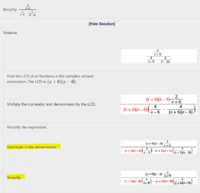You are using an out of date browser. It may not display this or other websites correctly.
You should upgrade or use an alternative browser.
You should upgrade or use an alternative browser.
common factors, how do i know which to cancel out?
- Thread starter bobisaka
- Start date
lev888
Elite Member
- Joined
- Jan 16, 2018
- Messages
- 2,994
Distribution follows this rule: a(b+c)=ab+ac.2 questions.
1. I am confused with distribution of the LCD.. can someone clarify how it works?
2.Is there are rule to cancelling out common factors? right to left? I believe when i did it, it did not match was in the solution.
View attachment 18604
Cancelling: (ab)/a = b. The order (ab or ba) doesn't matter.
Dr.Peterson
Elite Member
- Joined
- Nov 12, 2017
- Messages
- 16,861
You'll have to show how you canceled, in order for us to see if you made a mistake.2 questions.
1. I am confused with distribution of the LCD.. can someone clarify how it works?
2.Is there are rule to cancelling out common factors? right to left? I believe when i did it, it did not match was in the solution.
View attachment 18604
I think they made the distribution in the denominator obvious, but the canceling might be misunderstood, as they did a lot at once.
The only places they are canceling are within individual multiplications, one place in the numerator and two in the denominator. It helps many students if they rewrite the non-fractions as fractions. In the numerator, for example, we have [MATH](x+6)(x-6)\left(\frac{2}{x+6}\right) = \frac{x+6}{1}\frac{x-6}{1}\frac{2}{x+6}[/MATH], so the [MATH](x+6)[/MATH] in the numerator of the first fraction cancels with the [MATH](x+6)[/MATH] in the denominator in the last to leave [MATH](x-6)[/MATH] alone.
In general, when you have a product like [MATH]a\cdot\frac{b}{c}[/MATH], you can think of the [MATH]a[/MATH] "at ground level" and the [MATH]b[/MATH] "on the main floor" as at the same level, and the [MATH]c[/MATH] "in the basement" can cancel with either of the others. The product is equivalent to [MATH]\frac{ab}{c}[/MATH].

